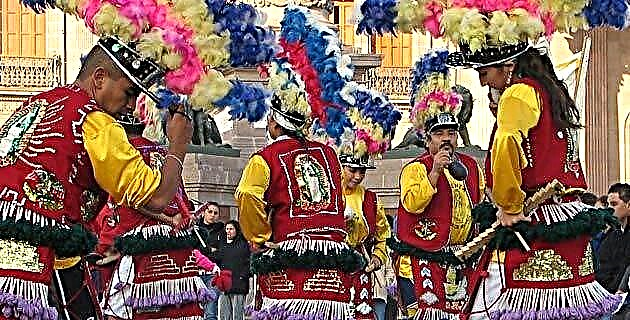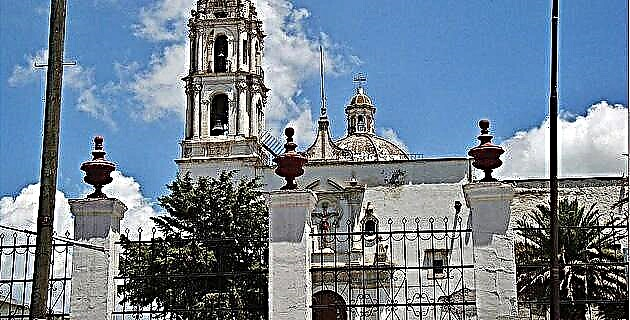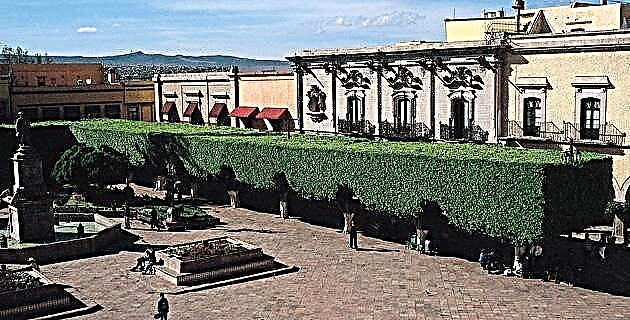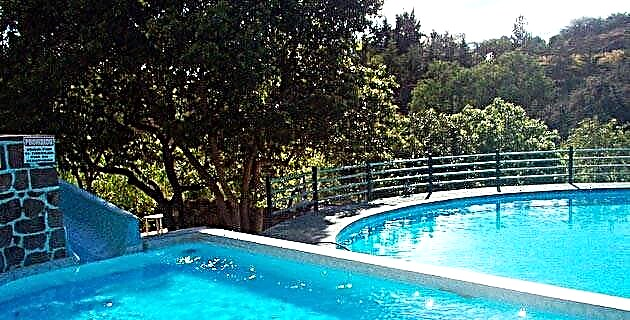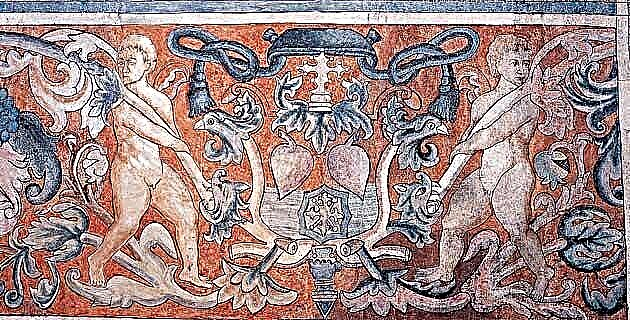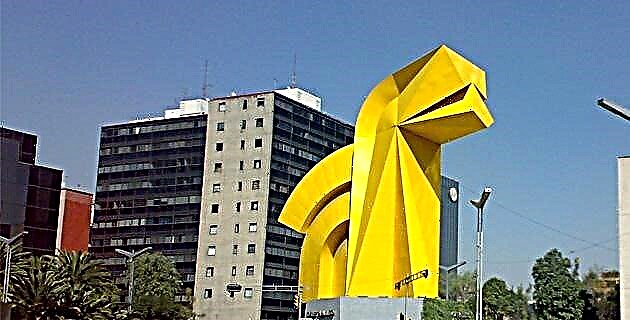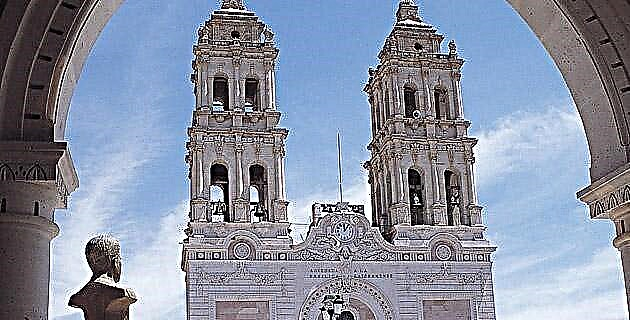
Sanctuary is the temple, generally located on the outskirts of a town, in which an image or relic is venerated. The Lord of the Rays has these characteristics and attracts a multitude of pilgrims, especially from the center of the Mexican Republic.
It doesn't matter the time or the day of the week. In the distance you can hear the sound of a bus. Traders, both established and itinerant, are enthusiastically preparing for good sales.
When the vehicle finally parks, people leisurely get out and wait. As soon as the last passenger gets off, everyone gets organized and begins their procession at a predetermined time by themselves.
The parade begins with the banner in front. The parishioners, the musicians and the rest of the participants, between songs, prayers and with slow steps, go to the church. When crossing the threshold of the atrium a bit of disorder is observed since some go on foot, reverently, while others continue their march on their knees, until they reach the altar.
It is about Temastián, a corner of the extreme northeast of Jalisco, in the municipality of Totatiche; place of pilgrimage where the Lord of the Rays is venerated. There are some devotees who prefer to come by car for a quick visit, while not a few take up to three or more days in their journey on foot from places as remote as Valparaíso, in Zacatecas or Aguascalientes.
The history of Temastián is closely linked to those of its neighboring towns: Totatiche and Villa Guerrero, since all three were erected as convents to evangelize the indigenous people. All on behalf of Franciscan friars, back in the late 16th century. The foundation was made taking Colotlán as its starting point, which by then was already serving as a religious and "political" center.
Strangely, of the three towns, the one that has grown the least as such over the centuries is Temastián, although it was the only one that became a cult center. Recent history records it this way from 1857, when the first festivals already dedicated to the Lord of the Rays were held. However, according to the legends, Temastián, which in Nahuatl means "the place of the baths" (from temacal, bath and tlan, place) was since ancient times a ritual site where different tribes came once a year to venerate. to some deity. In fact, the peasants of the place have different versions, one of them, that the Indians had "a saint" whom they visited, others say that in Temastián the ancients made their "mitotes" to ensure that there was enough hunting and rain.
Possibly the Franciscan friars, realizing that the natives frequented this site, perhaps on certain ritual dates such as solstices and equinoxes, decided to build the monastery there and, little by little, with the spiritual conquest, they simply changed the ritual dates and the deity. , giving continuity to the pilgrimage.
The church of Temastián has undergone several transformations, both architectural and decorative over the years. It is believed that the original chapel was very humble, that it had thatched roofs. Later, in the 18th century, it was built with better materials, its first tower dates from then, which remained unchanged until 1922, when the chaplain and benefactor, Fr. Julián Hernández C undertook the task of building a temple that stood out in the region, dedicated to the Lord of the Rays. The works lasted 12 years, until on January 11, 1934, the sanctuary was solemnly blessed. In 1947 the dome was completed and a little later the decoration and beautification of the entire enclosure, the atrium and the garden.
The Sanctuary of the Lord of Rays is made of white, purple and ocher quarry. In the foreground there is a spacious central plaza, separated from the atrium by a quarry trellis, topped with pilasters crowned by battlements.
The front facade of the church is simple, with a portal with two semicircular arches. In the center of the minor arch is the entrance door to the enclosure and above it the major arch, in the upper part of which appears the inscription: "AGREGADA A LA BASÍLICA LATERANENSE", alluding to the basilica of San Juan de Letrán, in Rome. On both sides of the façade there are symmetrical bell towers in a quadrangular shape, with large windows, four on each side, and spiked finishes.
The dome, for its part, has a stained glass drum, surrounded by quarry columns that support a frieze finished with elegant battlements. The dome is finished with the traditional lantern, with its cupola that ends in the respective cross.
The interior of the sanctuary is sumptuous, with filigree carvings in the quarry. The dome crowns the nave of the temple, dividing it into two transept and presbytery, to give the shape of a Latin Cross, typical of the constructions of the time.
The main altar has a very original design framed by the altarpiece composed of a wide quarry circle.
The altar itself is simple. It consists of the table and two steps that carry the same cornucopia ornament to the front, as seen in the niche of the crucifix. On both sides, there are two marble angels in an attitude of frank adoration.
In the back wall there are two doors in the shape of fans that give access to the sacristy.
Watching the parishioners in their acts of piety is quite an event. In addition, it is interesting to visit the Sanctuary's Hall of Altarpieces, where authentic works of art made in various techniques are exhibited: fresco, engraving, pencil, oil, pyrography, etc., and on materials as varied as canvas, wood, paper , stone or glass.
All these artistic manifestations were conceived as proof of gratitude for a granted miracle.
These works are by Mexican and Chicano authors. Undoubtedly the most interesting altarpieces are those made by the "apprentices" who use the language and spelling in a very particular way, such as the one that says "Doll thanks to Mr. De los Rayos for being relieved to my son from a paralysis childish. Jerez, Zac. January 1959 ".
This hall of votive offerings is also the ideal setting to observe the changes that daily life and popular art have undergone in the country. For example, in slab drawings we see the variation in fashions, or the means of transport used in the various periods of our history, from the humble cart to the plane, through the train and the bus.
The earliest date that appears on a votive offering is February 1891. The oldest works, which are exhibited on a long wall that do not get sunlight that filters through the windows, are protected within a long “ vitrina ”, which shows the desire to preserve and protect them on the part of the custodians of the sanctuary.
In addition to the votive offerings, in the Hall of the Altarpieces there are purses, crosses, diplomas, garments, braids, trophies, pieces for plastering legs and arms, baby shoes, etc. This leads us to the conclusion that a promise is made expecting a miracle in return and that ultimately the object of the promise is transformed into an offering. A very interesting cycle in the ritual life of any place of pilgrimage, regardless of nationality or religion.
The question hangs in the air, why is he called Lord of Rays? The answer lies in the legends, of which perhaps the most popular is the one that says that on one occasion the crucified Christ was struck by lightning that did not harm him. There are those who affirm that many years ago, many rays fell in that region, but that when the image of the Crucified arrived, the phenomenon stopped. These stories are very varied in their content and their outcome, and there is no shortage of those that give deeper interpretations, such as the one that Christ is called that way because of the rays of light that illuminate believers when their devotion is authentic. There is no shortage of skeptics who claim that the nickname is due to the three groups of seven rays that form the crown of Christ.
Now, the historical data and some legends settled in the book Historia de la Venerable Imagen del Señor de los Rayos, written by Canon Luis Enrique Orozco, assure that originally the image was known as El Señor del Rayo until, during A storm that fell on a group of missionaries who were teaching the doctrine under a mesquite, a ray fell on the image, which did not suffer any damage, only the cross, which by the way is preserved in the main altar, was cracked.
The traditional festivals are held on Ascension Thursday and January 11. On these dates, the crowd is such that the masses have to be celebrated outdoors, in the atrium, since the temple cannot accommodate so many parishioners. In those days there are many vendors offering food, candles, religious articles, and the odd trinket. The rest of the time, the sanctuary is very quiet and the visitor will enjoy a reverent silence only broken by the bell or the murmur of a prayer.

